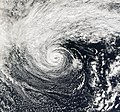Dosya:Storm 91C 01 nov 2006 2030Z.jpg

Bu önizlemenin boyutu: 642 × 599 piksel. Diğer çözünürlükler: 257 × 240 piksel | 514 × 480 piksel | 823 × 768 piksel | 1.097 × 1.024 piksel | 2.194 × 2.048 piksel | 6.000 × 5.600 piksel.
Tam çözünürlük ((6.000 × 5.600 piksel, dosya boyutu: 5,91 MB, MIME tipi: image/jpeg))
Dosya geçmişi
Dosyanın herhangi bir zamandaki hâli için ilgili tarih/saat kısmına tıklayın.
| Tarih/Saat | Küçük resim | Boyutlar | Kullanıcı | Yorum | |
|---|---|---|---|---|---|
| güncel | 18.58, 2 Ocak 2010 |  | 6.000 × 5.600 (5,91 MB) | Supportstorm | Reverted to version as of 00:19, 3 November 2006 |
| 20.41, 29 Aralık 2009 |  | 6.000 × 5.600 (5 MB) | Supportstorm | Image Adjustment: Auto levels on contrast and color | |
| 00.19, 3 Kasım 2006 |  | 6.000 × 5.600 (5,91 MB) | Good kitty | == Summary == {{Information |Description=Tropical storms, as their name suggest, tend to form in the tropics. However, from time to time similar looking storms can form at higher latitudes. Extratropical storms have cold rather than warm cores and usually |
Dosya kullanımı
Bu görüntü dosyasına bağlantısı olan sayfalar:
Küresel dosya kullanımı
Aşağıdaki diğer vikiler bu dosyayı kullanır:
- de.wikipedia.org üzerinde kullanımı
- en.wikipedia.org üzerinde kullanımı
- en.wikinews.org üzerinde kullanımı
- nl.wikipedia.org üzerinde kullanımı
- pt.wikipedia.org üzerinde kullanımı
- simple.wikipedia.org üzerinde kullanımı
- www.wikidata.org üzerinde kullanımı
- zh.wikipedia.org üzerinde kullanımı


